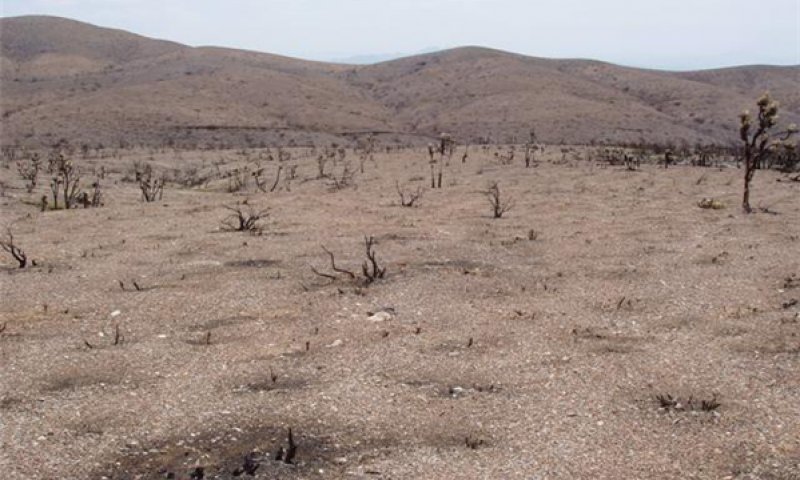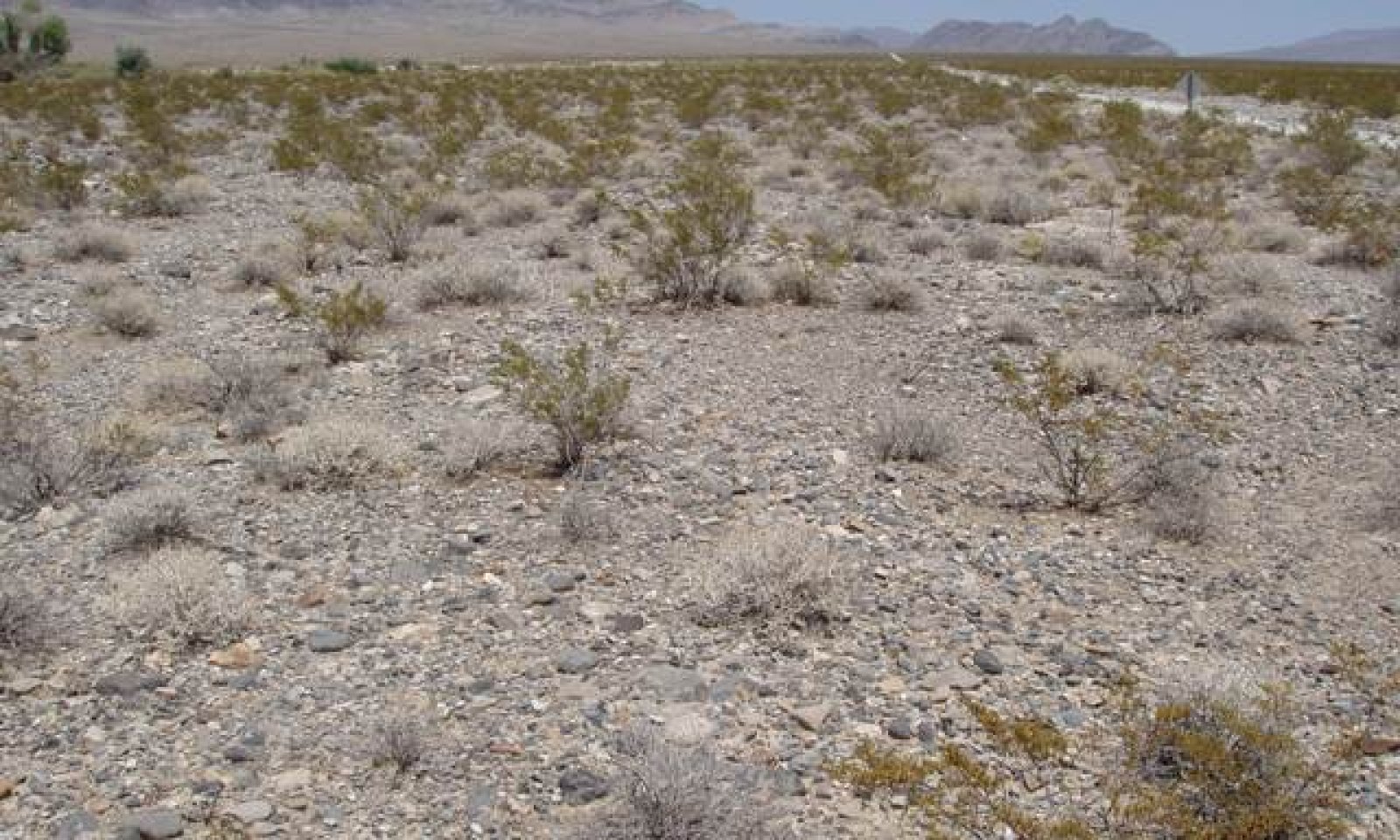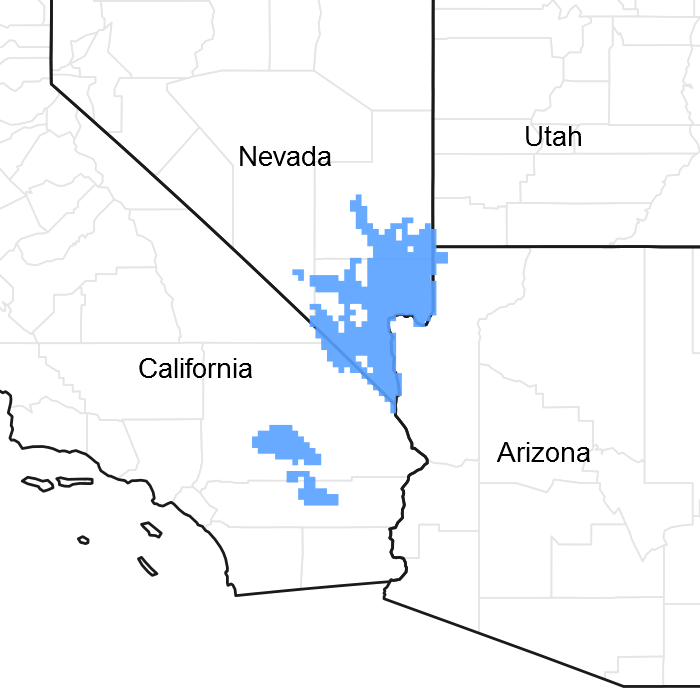Ecological dynamics
This white bursage-creosotebush plant community is extensive throughout the Mojave Desert and consists of both long and short-lived perennial species. In stable, old communities, creosotebushes or clones may attain ages of several thousand years. Defoliation and death of creosotebush branches may occur as a result of long periods of intense moisture stress. Surface disturbance on this site may reduce plant cover, density and diversity and increase erosion. These changes can be very subtle or extremely obvious depending on the intensity and rate of use and an assortment of environmental factors (topography, rainfall, soil type). White bursage generally dominates more developed soils with the ability to hold moisture in the upper soil profile. The shallow roots of white bursage are able to effectively use moisture stored in the upper horizons when it is available and survive for extended periods of time when it is not (Hamerlynck et al. 2002). White bursage is not able to dominate the deep, weakly developed, coarse textured soils that store water deep in the profile, which is ideal for creosotebush. The spatial distribution of soils allows white bursage and creosotebush to share dominance on this ecological site. They will share dominance throughout the successional process, although the relative abundance is likely to change (Marshall 1994). Creosotebush commonly uses white bursage as a nurse plant, young creosotebushes are frequently found rooted beneath mature white bursage plants (Marshall 1995). White bursage is well adapted to the desert environment but prolonged periods of drought will result a reduction of biomass and possibly kill the plant. Under historically stable conditions, low available fuel and a longer fire return interval allowed the establishment of long-lived desert perennial communities.
Nutrient availability in the Mojave Desert is characterized by resource pulses. High temperatures and relatively small rainfall events allow nutrients to accumulate during extended dry periods when plant and microbial growth is restricted. When rainfall events do occur, they trigger biological activities including plant growth and nutrient uptake (Collins et al. 2008). Resource pulse availability is strongly correlated to the presence of microbiotic crusts in arid systems. Microbiotic crusts fix both carbon and nitrogen, and can be considered functional resource reserves. These reserves have lower activation thresholds in relation to water availability than plants, creating nonlinear ecosystem interactions (Collins et al. 2008). This relationship facilitates plant growth in arid environments and allows plants to utilize nutrients that would otherwise remain unavailable during small precipitation events.
The frost-free season can last for the better part of a year: however, vegetation is limited by nutrient availability. Nutrient concentrations in this shrub community are spatially variable. Nutrient resources are concentrated under the shrub canopy relative to the interspaces, called islands of fertility (Kieft et al. 1998). Fine, sandy alluvium on these sites provides material that the wind redistributes to mound-like coppice dunes beneath creosotebush canopies. Heights of coppice dunes increase as a function of creosotebush cover and are tallest on young alluvial surfaces. Moisture absorbed by and stored in the coppice dune enhances plant performance, in turn contributing to the plant’s effectiveness as a windbreak allowing for further deposition of eolian sands (McAuliffe et al 2007).
Destructive impacts such as land clearing can reduce long-lived creosotebush. The opportunistic perennials such as white bursage, rayless goldenhead (ACSP), white burrobush (HYSA), and wire lettuce species (STEPH) will increase. With a loss of perennial cover, non-native annual grasses and forbs such as red brome (BRRU2), Mediterranean grass (SCBA), and redstem filaree (ERCI6) will readily invade this site.
Fire Ecology:
Prior to Euro-American settlement, fire regimes in Mojave Desert shrub communities were characterized by relatively infrequent, stand-replacing fires. Mojave Desert communities are usually unaffected by fire due to low fuel loading, although a year of exceptionally heavy winter rains can generate fuels by producing a heavy stand of annual forbs and grasses. Plant species, native to the Mojave Desert, produce very little biomass, and communities generally have large interspaces, characteristics which are not conducive for carrying fire across the landscape. An altered fire regime can be detrimental to native plants that are not adapted to a frequent fire return interval. Fire can increase resource availability by reducing the amount of resources (moisture, nutrients) used by resident vegetation through mortality or injury (Zouhar et al. 2008). This increased resource availability can make the ecosystem more susceptible to invasions. Relative competitive ability post-fire controls the invasibility of a system. Often non-natives have superior competitive ability for resources such as water, nutrients and light. When fires do occur, the effect on the ecosystem may be extreme due to the harsh environment and the slow rate of recovery. White bursage and creosotebush possess limited sprouting ability, thus can be killed by fire. White bursage, however, can rapidly re-establish from off-site seed. Range ratany is top killed by fire and resprouts from the root crown post-fire. Nevada ephedra is top killed by fire, but commonly resprouts and may increase in cover. Damage to big galleta from fire varies. If big galleta is dry, damage may be severe. However, when plants are green, fire will tend to be less severe and damage may be minimal, with big galleta recovering quickly. The loss of native vegetation can be followed by invasion of non-native annual forbs and grasses.
State 1
Reference State
The reference state is representative of the natural range of variability under pristine conditions. Community phase changes are primarily driven by changes in weather patterns and natural disturbances such as long-term drought and insect attacks. Wildfire is infrequent and patchy due to low fuel loading and widely spaced shrubs. Timing of disturbance combined with weather events determines plant community dynamics. The reference state has two community phases; one community phase dominated by mature shrubs and sparse herbaceous vegetation, the other community phase is dominated by native herbaceous vegetation with a recovering shrub component.
Community 1.1
Reference Plant Community
The reference community phase is dominated by white bursage and creosotebush. Perennial native grasses include big galleta, Indian ricegrass (ACHY) and desert needlegrass (ACSP12). Potential vegetative composition is about 10 percent perennial and annual grasses, 10 percent annual and perennial forbs and 80 percent shrubs. Approximate ground cover (basal and crown) is 15 to 25 percent. Under natural conditions the reference community is stable and long lived. Prolonged drought results in an overall reduction of the plant community.
Table 5. Annual production by plant type
| Plant type |
Low
(kg/hectare) |
Representative value
(kg/hectare) |
High
(kg/hectare) |
| Shrub/Vine |
179 |
269 |
448 |
| Forb |
22 |
34 |
56 |
| Grass/Grasslike |
22 |
34 |
56 |
| Total |
223 |
337 |
560 |
Table 6. Soil surface cover
| Tree basal cover |
0%
|
| Shrub/vine/liana basal cover |
5-20%
|
| Grass/grasslike basal cover |
1-5%
|
| Forb basal cover |
1-25%
|
| Non-vascular plants |
0%
|
| Biological crusts |
1-15%
|
| Litter |
15-35%
|
| Surface fragments >0.25" and <=3" |
5-70%
|
| Surface fragments >3" |
0-5%
|
| Bedrock |
0-5%
|
| Water |
0%
|
| Bare ground |
5-50%
|
| Jan |
Feb |
Mar |
Apr |
May |
Jun |
Jul |
Aug |
Sep |
Oct |
Nov |
Dec |
| J |
F |
M |
A |
M |
J |
J |
A |
S |
O |
N |
D |
Community 1.2
Plant Community 1.2
This community phase is characteristic of a post-disturbance plant community. Herbaceous biomass initially increases, sprouting shrubs recover quickly and provide favorable sites for the establishment of shrub seedlings. Plant community composition may vary depending on season of disturbance. This community phase is ‘at-risk’ of invasion by non-native species. Non-natives are able to take advantage of increased availability of critical resources following disturbance.
Pathway 1.1a
Community 1.1 to 1.2
Insect attack, low intensity, patchy wildfire and/or other localized disturbance.
Pathway 1.2a
Community 1.2 to 1.1
Absence from disturbance and natural regeneration over time.
State 2
Invaded State
The invaded state is characterized by the presence of non-native species. Compositionally, State 2 is similar to the reference state with a trace of non-natives in the understory. However, ecological resistance and resilience is reduced by the presence on non-native species, making it more difficult for this state to recover following a disturbance. Non-native annuals are highly flammable and promote wildfire where fires historically have been infrequent. State 2 has three community phases. One phase is similar to the reference community phase with a trace of non-natives in the understory. The second community phase is dominated by herbaceous vegetation, native and non-native. The last community phase has reduced perennial native vegetation and stable to increasing non-natives.
Community 2.1
Plant Community Phase 2.1

Figure 6. Limy 5-7 with trace of non-natives
This community phase is characterized by the presence of non-native species. Species composition and ecological processes (soil hydrology, nutrient cycling, and energy capture) is similar to the reference community phase. However, ecological resilience is reduced by the presence of non-natives. Non-natives are favored and will increase if disturbance regimes vary from the range of historic variation. This plant community responds differently following disturbance, when compared to non-invaded communities. Prolonged drought will result in an overall reduction of above ground biomass, including non-native annuals.
Community 2.2
Plant Community Phase 2.2

Figure 7. wildfire
This community phase is characteristic of a post-disturbance plant community and typically occurs following wildfire or other large disturbance that removes mature shrub canopy. Initially herbaceous biomass increases, which may or may not be dominated by non-native annuals. Sprouting shrubs quickly recover and serve as nurse plants for other shrub seedlings. Seedlings are dominated by white bursage and brittlebush species (ENCEL). This plant community is ‘at-risk’ of reoccurring wildfire. Increased herbaceous biomass, mainly non-native annuals, provide a continuous bed of fine fuels that promote the spread and decrease the spatial variability of wildfire.
Community 2.3
Plant Community Phase 2.3
This community phase typically occurs following reoccurring heavy surface disturbance and is characterized by a reduction in total shrub canopy. Non-native annuals persist and may increase with increased disturbance. Shrubs experience reduced vigor and reproductive capacity due to soil compaction and competition from non-natives. Decline in the cover of deep-rooted native perennial shrubs and bunchgrasses, results in reduced soil moisture and increased runoff.
Pathway 2.1a
Community 2.1 to 2.2
Plant Community Phase 2.1
Plant Community Phase 2.2
Low intensity, patchy wildfire, insect/disease attack or other localized disturbance.
Pathway 2.1b
Community 2.1 to 2.3
Reoccurring surface disturbance.
Pathway 2.2a
Community 2.2 to 2.1
Plant Community Phase 2.2
Plant Community Phase 2.1
Absence from disturbance and natural regeneration over time.
Pathway 2.3a
Community 2.3 to 2.2
Absence from disturbance, changes in management and natural regeneration over time.
State 3
Annual State
The non-native annual state is characterized by a significant reduction or loss of deep-rooted native perennials and a frequent disturbance return interval. Frequent and repeated disturbances, including wildfire favors the establishment of a non-native annual dominated state. Non-native annuals perform well under a frequent disturbance return interval due to their annual growth form, persistent seed bank and competitive ability. State 3 has two general community phases. One community phase is indicative of a post-fire community and is dominated by non-native annuals. The second community phase is characterized by the recovery of short-lived, native, woody perennials, such as white bursage, shadscale (ATCO) and brittlebush species.
Community 3.1
Plant Community Phase 3.1
This community phase is heavily dominated by non-native annuals. Non-native annuals benefit from fire and often outcompete natives for nutrients, water and light resources following fire or other disturbance. Ecological processes (infiltration, nutrient cycling and energy capture) are controlled by non-native species. Changes in these processes often cause changes in dynamic soil properties such as soil aggregate stability, which may affect water availability, resistance to erosion and eventually production.
Community 3.2
Plant Community Phase 3.2
This community phase is characterized by an overstory of short-lived native perennials (white bursage, shadscale, etc) and an understory of non-native annuals. The abundance of non-natives in the understory hinders the reestablishment of native shrubs by competing for water and nutrients. The continuous bed of fine fuels provided by non-native annuals increases the size and decreases the spatial variability of wildfires, preventing the recovery of long-lived native woody perennials. Prolonged drought reduces overall plant community production and cover.
Pathway 3.1a
Community 3.1 to 3.2
Absence of disturbance and natural regeneration over time.
Pathway 3.2a
Community 3.2 to 3.1
Wildfire and/or other localized disturbances.
Transition T1
State 1 to 2
Trigger: Introduction of non-native species
Slow variables: Surface disturbance, changes in the kinds of animals and their grazing patterns, drought and/or changes in fire history that altered the recruitment rate of native species.
Threshold: Non-native species cannot be easily removed from the system and have the potential to significantly alter disturbance regimes from their historic range of variation. Changes in the herbaceous understory, associated with the introduction of non-native annuals, reduce ecological resistance and resilience following a disturbance.
Transition T2
State 2 to 3
Trigger: Frequent and repeated wildfire
Slow variables: Increased reproduction and cover of non-native invasive annuals.
Threshold: Reduction in the deep-rooted perennial native herbaceous understory and severe reduction or loss of native shrubs leads to changes in soil hydrology; reducing infiltration and increasing runoff. Modified fire regime; including changes in the frequency, intensity, size and spatial variability of fires.





